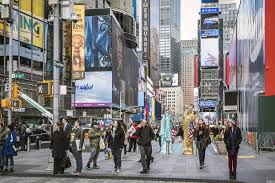26 of the 48 state Medicaid agencies studied could not report the number of “critical incidents” — such as abuse, neglect or exploitation.
You are here
New York, New York – Age Friendly, Age-Supportive Innovations
 Largest city in the US shows a path for an aging society. New York has long been a host and leader in supporting older adults, from being a WHO Age Friendly City, to acknowledging the presence of Naturally Occurring Retirement Communities (NORCs) starting in 1994, to being the home of the first Virtual Senior Center (VSC). In addition, technology leadership initiatives have been offered via SelfHelp in Queens, and Senior Planet, a technology exploration center that offers tech training for adults 60+. So many people aging, many needing the skills to find and keep jobs. So they utilize services like OATS and Senior Planet, or senior centers, training in libraries, carrier stores and online sites like AARP TeK Academy.
Largest city in the US shows a path for an aging society. New York has long been a host and leader in supporting older adults, from being a WHO Age Friendly City, to acknowledging the presence of Naturally Occurring Retirement Communities (NORCs) starting in 1994, to being the home of the first Virtual Senior Center (VSC). In addition, technology leadership initiatives have been offered via SelfHelp in Queens, and Senior Planet, a technology exploration center that offers tech training for adults 60+. So many people aging, many needing the skills to find and keep jobs. So they utilize services like OATS and Senior Planet, or senior centers, training in libraries, carrier stores and online sites like AARP TeK Academy.
Cities like New York can cultivate technology and services for older adults. Given the city’s scale (not to mention the number of technology organizations and NYC Broadband, among other initiatives), not to mention there are 1 million people aged 65+ as of 2010, this should not be a surprise. New York City has been designated an Age Friendly City by the World Health Organization – and has seen up close the issues with an aging population – only beginning to be detected in cities with far fewer older adults. Reports of cities with growing percentage of older adults (like Cleveland, population 389,500 in 2014) mask the sheer volume of New Yorkers (8.5 million) clustered in a densely populated and increasingly expensive geography. [Of course, ‘older’ doesn’t mean old any more – even the word has just been redefined, with new charts spelling out the definition of the new old age.]
High school kids learn how to be CNAs. Maybe you knew about this? This possibly remarkable program was featured in the Wall Street Journal this week and has been operating since 2006, training high school students how to be Certified Nursing Assistants (CNAs) in geriatric care. Remember the AARP caregiver support ratio (CSR) problem – the lack of prospective caregivers in the age range of 46-64 to care for the 80+ population. Well, it is looming just ahead for aging boomers in NYC – and only 3.05 people in the age range of 18-64 by 2030. With 112,000 available beds in nursing homes by 2010, and a population of 2.5 million individuals aged 65+ today, this high school training is timed well -- there is a worsening shortage of home care, CNAs, and home health care workers – and not just in New York. For those looking at the booming home care industry as an area of investment or observing the worsening nurse shortage, consider cultivating young people to start on this career ladder at the age of 17 or 18.
Improve Aging Hack. Ideas from individuals in their 70’s and 80’s at this intriguing session focused on transportation, care, intergenerational housing, and reverse-mentoring of young to the old. The most significant aspect, and easily replicated elsewhere, was to include older adults in brainstorm about new offerings, versus simply being recipient of service ideas invented by others. Come to think of it, this should not mimic a ‘lively’ focus group -- where startup entrepreneurs offer up poorly researched "I had a grandmother" offerings. Wouldn't it be a breakthrough if each of the ideas, pitched business plans, and AARP innovation champions crafted tech offerings that were available now, clearly aimed at older adults who could benefit, like some of the aging population in New York City.
